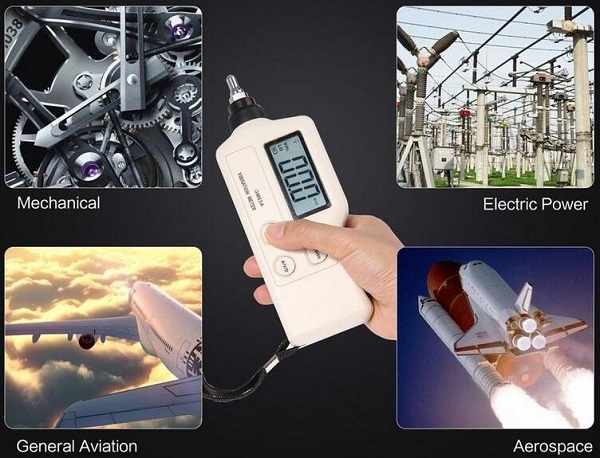A vibration meter is a handheld or portable instrument used to measure various parameters associated with mechanical vibrations. These devices are commonly used in predictive maintenance, reliability engineering, and industrial applications to assess the condition of machinery and structures. Vibration meters help identify and diagnose issues like imbalance, misalignment, bearing wear, and other mechanical problems that can lead to equipment failure. sisco shop introduces you to how the vibration meter works.
Principles of Operation
The operating principle of a vibration meter is based on the kinematics and mechanics of vibration. When the equipment under test is in operation, the resulting vibrations are propagated to the measuring point, usually at the bearings of the equipment. The vibration meter measures these vibrations by means of sensors, and the resulting signals are converted into electrical signals. The vibration meter's computer converts these electrical signals into numerical values, which are parsed and analyzed by software to produce a measurement of the equipment's vibration level.
Operation Procedure
1. Sensing Mechanism:
Vibration meters employ various sensing mechanisms to detect the motion or vibrations of the object or structure being measured. The choice of sensor depends on the type of vibration meter. Common sensing mechanisms include accelerometers, velocity sensors, and displacement sensors.
Accelerometers: Accelerometers are commonly used in vibration meters. These devices consist of a mass or a piezoelectric element that responds to acceleration. When the object vibrates, the mass or piezoelectric element within the accelerometer experiences acceleration, and this generates an electrical signal proportional to the vibration. The accelerometer measures the rate of change of velocity, allowing it to capture information about both the frequency and amplitude of the vibrations.
Velocity Sensors: Velocity sensors, such as geophones or electromagnetic velocity transducers, measure the velocity of the vibrating object. They generate an electrical signal that corresponds to how fast the object is moving back and forth. These sensors can provide information about the amplitude and frequency of vibrations.
Displacement Sensors: Displacement sensors, like laser displacement sensors or capacitive sensors, directly measure the displacement or movement of the vibrating object. They provide information about how far the object is displaced from its equilibrium position.
2. Signal Conditioning:
The electrical signal generated by the sensor is typically weak and may contain noise. Therefore, the vibration meter includes signal conditioning circuitry to amplify and filter the signal. This step helps to enhance the accuracy and readability of the vibration measurements.
3. Data Analysis and Display:
The conditioned signal is then analyzed and processed to extract relevant information about the vibration, such as its frequency, amplitude, and other parameters. Vibration meters may feature built-in displays or interface with external devices like computers or data loggers to provide real-time readouts and data storage.
4. Units and Readouts:
The vibration meter usually displays the vibration measurements in units of amplitude, frequency (Hertz), or other relevant parameters, such as peak acceleration (m/s²) or peak velocity (mm/s). These units help users understand the magnitude and characteristics of the vibration.
5. Alerting and Alarming:
Some vibration meters are equipped with alarm thresholds, and they can trigger alerts or alarms when vibrations exceed predefined levels. This feature is particularly useful for monitoring machinery and structures for safety and maintenance purposes.

Common Types
1. Contact-Based Vibrometers:
Contact-based vibrometers require physical contact with the object or surface being measured. They typically consist of a probe or sensor that makes direct contact with the vibrating object. The sensor detects the motion or vibrations and converts them into an electrical signal, which can then be analyzed or displayed. There are different types of contact-based vibrometers, such as accelerometers and velocity sensors:
a. Accelerometers: These sensors measure the acceleration of an object in response to vibrations. When the object vibrates, the accelerometer's mass or piezoelectric crystal inside the sensor experiences acceleration, and this generates an electrical signal proportional to the vibration.
b. Velocity Sensors: Velocity sensors measure the velocity of the vibrating object, indicating how fast it is moving back and forth. They often use a coil and magnet arrangement to generate a signal based on the object's velocity.
2. Non-Contact-Based Vibrometers:
Non-contact-based vibrometers are also known as laser vibrometers or optical vibrometers. These devices do not require physical contact with the vibrating object, making them ideal for measuring vibrations in delicate or hard-to-reach areas. They work on the principle of interferometry, and their operation can be described as follows:
a. Laser Beam: A laser beam is directed at the surface of the object under investigation.
b. Reflected Beam: The laser beam reflects off the vibrating surface. The frequency and phase of the reflected beam are affected by the surface's motion due to vibration.
c. Interferometer: The reflected beam is combined with a reference beam from the same laser, creating an interference pattern.
d. Photodetector: The interference pattern is captured by a photodetector, which converts it into an electrical signal.
e. Signal Analysis: The electrical signal is then analyzed to determine the frequency, amplitude, and phase of the vibrations. The resulting data can be used to characterize the object's vibration properties.
Vibration meters play a crucial role in ensuring the reliability, safety, and efficiency of various mechanical systems and structures. They are essential tools for professionals in maintenance, engineering, and quality control across multiple industries. sisco shop offers high quality, reasonably priced vibration meters for sale online, such as handheld pen vibration meters, portable digital vibration meters, and other vibrometers, if you are interested in it, welcome to click and buy.

